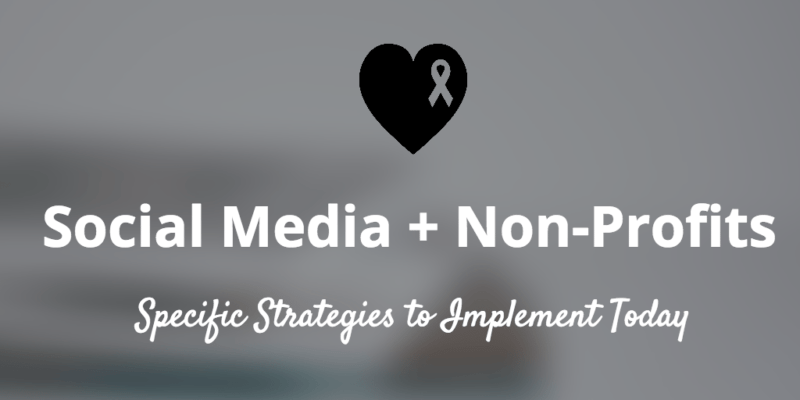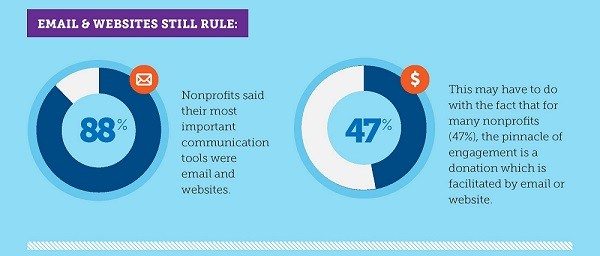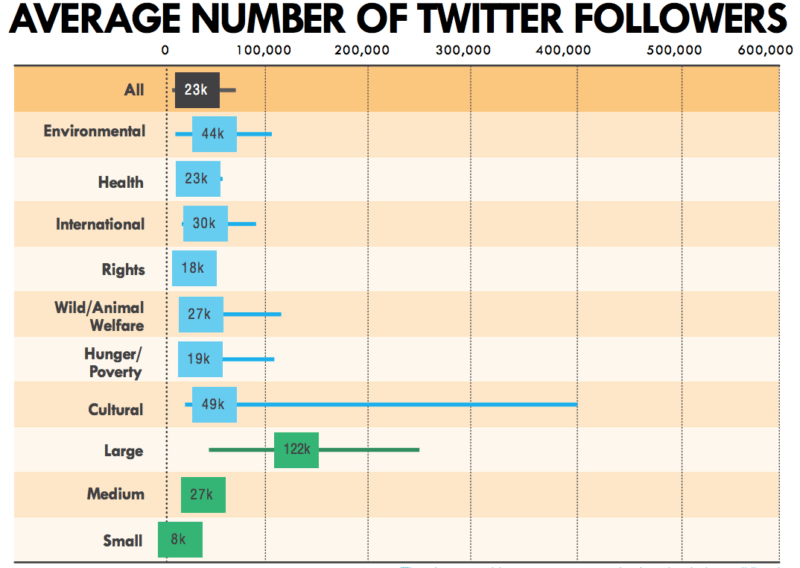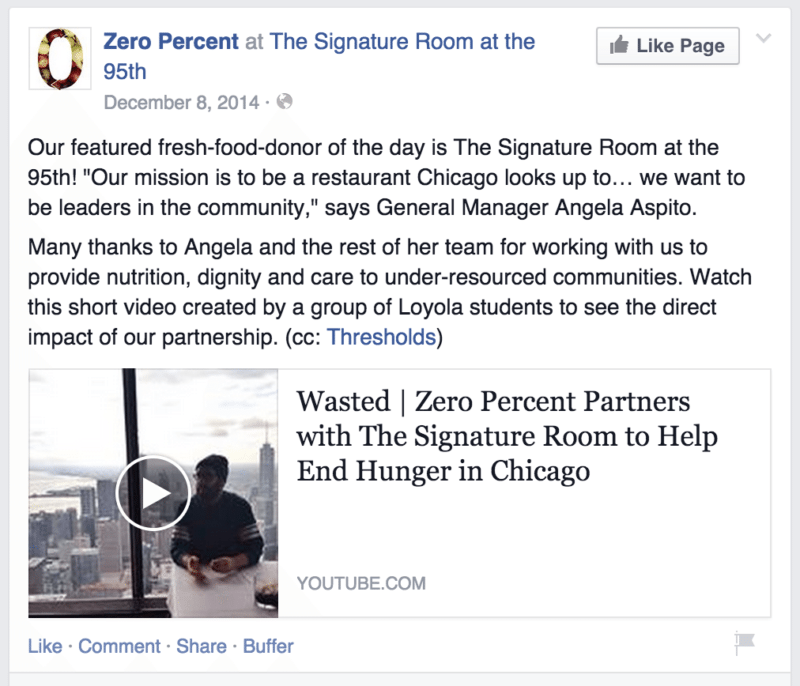Whenever we have the chance to chat with folks about social media stats and marketing strategies, we are amazed at the many unique ways you all go about charting a path to social media success.
Every industry and niche—every social profile, even—is unique.
Non-profits are a great example of a segment of social media with its own unique elements and expectations. The non-profit structure—donation-backed, humanitarian-focused, member-based—presents an opportunity for some really neat ways of putting social media to good use, and I’ve done my best to collect a number of stats, tips, and strategies here in this post.
Do you run a non-profit? Do you help your non-profit share to social media? I’d love to learn from your experience also.

Survey Says … How Non-Profits Share to Social Media
1. The pinnacle of engagement
What is the absolute best form of engagement your community could give you or your business?
A mention on social media?
A 1:1 email conversation with you?
A share of something you’ve written on your blog?
Nearly half of non-profits (47%) find that the pinnacle of engagement is a donation.
This data comes from a survey performed by the Case Foundation, which goes on to highlight the connection between this pinnacle of engagement and its effect on how non-profits view their different marketing channels, including social media:
Nonprofits overwhelmingly (88%) said their most important communication tools were email and their websites, even though fully 97% of them are on Facebook. This may have to do with the fact that in their mind, the pinnacle of engagement is a donation (47%). Clearly, simply getting folks to retweet or comment (18% each) is helpful only to the extent it culminates in financial support, which still typically happens through a donate page.

How does social media fit into a marketing strategy when a non-profit’s focus is quite donation driven? (I’ll hope to offer some answers below.)
2. The case for social media—it’s growing, fast!
Though email and websites still rule as non-profit marketing channels, social media is catching up. In Social Media Benchmark Study’s 2015 report, they found the following:
- Email list sizes grew 11% in the past year
- Facebook and Twitter followers grew 42% and 37%, respectively
For non-profits, social media is growing 3x faster than email.
In terms of total numbers, email still dwarfs social. For every 1,000 email subscribers, non-profits have on average 285 Facebook fans and 112 Twitter followers.
But the gap is closing.
Here are some benchmark numbers of where non-profits stand in terms of social media followers, broken down by segment.


(The Small, Medium, Large distinctions in the charts above are based on a non-profit’s total number of email subscribers. Small non-profits are those with 100,000 or fewer subscribers. Medium is 100,000 to 500,000. Large is 500,000 and up.)
3. Many non-profits are short on social media staff
Social Media Benchmark Study’s 2012 results claimed that nonprofits only allocated 1/4 of one full-time person to social media marketing. Case Foundation’s 2014 study (two years later) found that the number had increased, if only slightly: Half of survey respondents had one full-time or part-time person doing social media. For the remaining half, one quarter used a social media team, the other quarter is ad-libbing it.
The same Case Foundation report found lack of staffing to be the biggest challenge for non-profits.
With this being the case, it becomes all the more important to share to social media as efficiently as possible, saving as much time as possible.
4. The preferred social networks for non-profits
Most every non-profit is on Facebook. Quite a few are on Twitter, and many do LinkedIn and YouTube, too.
In a HubSpot survey of small-to-medium non-profits in the U.S., here’s the breakdown of the top 10 social networks used by non-profits:
- Facebook (98%)
- Twitter (~70%)
- LinkedIn (~55%)
- YouTube (~45%)
- Pinterest (~25%)
- Instagram (~15%)
- Google+ (~15%)
- Flickr (~10%)
- Tumblr (~5%)
- SlideShare (<5%)

The HubSpot survey also had a number of other fascinating insights into how these non-profits spend their time on social media. In particular, the following tidbits stood out:
- Most nonprofits do not have a documented social media strategy.
- Responsibility typically falls to only one employee.
- Tracking the social media accounts of donors within a donor database is a rare practice.
And, to highlight the effect of having little staff to handle social media, HubSpot’s survey found that more than half of non-profits spend 2 hours or less per week on social media marketing (whereas half of for-profit businesses spend at least 6 hours per week).

5. What do non-profits measure?
HubSpot found that about half of non-profits measure their social activities, which is about twice as good as the average for for-profit businesses.
What are non-profits measuring?
The Case Foundation’s study found that the most popular social media measurement tool is Facebook Insights, which makes sense given Facebook’s popularity among non-profits.
(The second most popular metric is Twitter followers.)
As far as what non-profits do with the info from Facebook Insights, the Case Foundation made this discovery:
Fully 60% of our audience still believe that there is no benchmark for what an average engagement rate is on Facebook. Twenty-two percent said the benchmark was 2-4%, but from our personal experience, only the most engaging posts from nonprofits with highly active communities can hope to attract those numbers.
(For our Buffer Facebook page, we reach between 2-3% of our fans.)
An Easy-to-Follow Social Media Strategy for Non-Profits

One more finding that stood out from the Case Foundation survey was that 74 percent of non-profits use social media as a megaphone to announce events and share what they’re up to, instead of seeking out conversation.
Moving away from this mentality—a simple change in perspective and strategy—could make a big difference in social media results.
One way to ensure the content you share on social is balanced with a mix of megaphone and conversation is to use a social media sharing plan. We’ve covered some useful plans before:
- 4-1-1 – 4 pieces of content from others, 1 reshare, 1 self-serving post
- 5-3-2 – 5 pieces of content from others, 3 from you, 2 personal updates
- Golden Ratio – 60% others’ content, 30% your content, 10% promotional
- Rule of Thirds – 1/3 posts about you, 1/3 curated content, 1/3 conversations
Steven Shattuck at HubSpot has found these formulas to be useful for many businesses yet “curiously and uniquely inadequate for nonprofits.”
He proposes a three-part system for non-profits, the “Three A’s”:
- Appreciation
- Advocacy
- Appeals
Appreciation – 1/3 of your social updates should recognize your donors, supporters, volunteers, and employees
Advocacy – 1/3 should engage and share with the content of other groups or nonprofits who are relevant to your area
Appeals – 1/3 should solicit donations or help

29 No-Cost, Simple Strategies That Non-Profits Can Implement Today
1. Highlight a donor of the day or donor of the week.

These kinds of simple moments of appreciation can be powerful for building connections with your communities, and they can often make for attention-getting, visual content. (Bonus: The people you highlight will share with their friends.)
2. Interact with relevant pages and profiles
In addition to building community by highlighting your donors, you can also connect with those fellow nonprofits and companies who support your mission. Stay involved with their updates and shares by liking, favoriting, retweeting, sharing, and commenting. It’s great for community-building and helps boost your visibility to boot.
3. Tweet to landing pages with specific asks
You can bring clean water like this to someone in need with one $30 donation right now at http://t.co/ZZeKOfhWfC pic.twitter.com/C5RD2hheFY
— charity: water (@charitywater) June 15, 2015
If you have payments enabled on your website, send social media traffic back to your site and to specific landing pages. Make 5, 10, 20, or more landing pages, each with a specific ask, then compose a social media message to accompany each of these pages (part of the 1/3 “Appeals” section listed in the above strategy).
4. Create behind-the-scenes content
Non-profits by nature are a bit more open than traditional business. Take full advantage by sharing behind-the-scenes: Backstage at events, inside your planning sessions, around the office, etc.
5. Create and share a simple crowdfunding campaign
As an alternative to events or dinners, you can create a simple crowdfunding page (Crowdrise is a great spot) and share this with your social media followers, asking for a quick-and-easy donation.
6. Encourage peer-to-peer asks
Tools like Classy make it possible for your supporters to set up their own fundraising pages. They can then share these pages with their own followers, enabling a strong sense of 1:1 support.
7. Post a thank you message on a sponsor’s page
Thanking those who help make your work possible—everyone from donors to employees to sponsors—is a great way to fill the 1/3 appreciation section of your strategy. Sponsors pages in particular can be great places to engage as they likely have a strong following as well. Share a thank you on their page, and add one to your page, too.
8. Include an image in your tweets
From Noland Hoshino:
Twitter is like looking out the window of a fast moving train. If you insert insert a “billboard” (photo or graphic image) tweet, people will notice it.
(We’ve seen up to double the engagement with this strategy.)
9. Ask questions in your social media posts.
These tend to encourage conversation with your community and lead to higher amount of interactions and responses.
10. Share your content more than once
Here are some simple ideas from Lauren Girardin:
Share just the headline, write a tweet in an alternate engaging format (e.g. ask a question, quote a juicy bit), add an image, try a new hashtag, share at a different time of day or on the weekend, or add ICYMI (in case you missed it).
11. Track your social media mentions
We’ve written before about some great tools for social media monitoring. Mention is a favorite of ours here at Buffer.
12. Organize accounts into Twitter lists
You can build Twitter lists for just about anything: VIP supporters, sponsors, press, influencers, partners, fellow nonprofits, etc. And if you need to, any Twitter list can be made private.
13. Use Twitter lists for research
Look through the lists of your followers to find new, relevant people and accounts to follow.
14. Monitor and analyze those who follow you
Keep an eye on the new accounts who are following you. They might have great influence in an important area to you or have many followers you can reach out to. Social Rank is a simple and powerful tool for sorting through Twitter followers in this way.
15. Enlist a group of supporters to engage with your content
If you’re just getting started on social media, you might not be able to get great engagement form the start. To avoid the empty look and feel of a new account, encourage a small and active group of supporters to engage with your content.
16. Find and engage with influencers in your area

Followerwonk shows you analysis of your Twitter followers, including a map with a breakdown of where specifically each follower is. Keep clicking the map to get more and more granular with the location (country > state > city). To access this report, log in at Followerwonk and choose an Analyze report, with your @username and “analyze their followers.”
17. Discover the connections of your team
Tap into the networking aspect of social networking, on LinkedIn in particular, by looking at the connections of those in your organization.
18. Use closed groups on LinkedIn or Facebook
Chat internally with your team on LinkedIn or Facebook to help share resources or ideas. Also great for connecting with a team of volunteers or a board of advisors.
19. Reserve your name in all social media platforms.
KnowEm is a great place to visit to see which social networks you’ve yet to claim.
20. Create your own Wikipedia page
Wikipedia pages can be great for social sharing and for helping manage your brand online. (They’re pretty great for SEO, too.) To create a page, go to the entry creation page at Wikipedia, and once you’ve created the entry, be sure to check back often and track any changes.
21. Allow social media as a communication preference for your members
Many people (millenials in particular) may prefer any notifications or messages to come via social media. You can add these folks to a group or list and message them directly when you might otherwise send an email.
22. When someone registers at your site, ask for a social media profile
This can be a simple extra field in your signup form (or for the especially tech-savvy, you can add social sign-in to your forms). Once you have the social media info, you can connect with this person and store his or her social media info in your donor database.
23. Offer text-to-give & tweet-to-give
As social media continues to go mobile, your payments can, too. Text-to-give is a slick way to help those who want to donate to be able to donate quickly.
Same goes for those who might want to donate directly from Twitter. You can register your non-profit at Charitweet to enable simple, micro-donations direct from Twitter.
24. Add social media PR contacts to your list
If you’re looking for press coverage for your non-profit, instead of going the traditional news route, you can find many great contacts online, including online-only publications and journalists who are primed for your topic. Some smart searches (“PR,” “[your topic],” “[your area],” etc.) can reveal some leads worth following.
25. Have a social media person on your board
Find someone who knows their stuff on social media and can help with formulating strategies or making plans should something go wrong on social.
26. Schedule routine drive-bys of your social media accounts
Fifteen minutes in the morning, afternoon, and evening may be enough to catch up on what’s been happening on your social accounts.
27. Find and participate in Twitter Chats
Share your expertise and connect with like-minded people. You can search in a chat tool like Twubs to find a relevant Twitter chat on your area.
28. Respond to everyone
Responding completely is one way to help set yourself apart on social media. And if possible, it’s great to respond in a timely manner, typically 24 hours or less (or a couple hours or less on Twitter).
29. Ask about non-profit discounts for your favorite tools
Many online tools offer discounts for non-profit businesses.
10 Helpful Tools for Non-Profits
- Crowdrise – Crowdfunding platform ideally suited for nonprofit fundraising
- Amazon Smile – You can set up your organization to receive donations from Amazon purchases
- Classy, First Giving & Blackbaud – Peer to peer fund raising
- Mention – Social media monitoring
- Buffer – Social media scheduling and management
- Google for Non-Profits – Discounts on products for nonprofits
- Piryx – Web payments for non-profits
- Bloomerang – Fundraising management & software
- Harvest & Donate.ly – Online payments and donations for your website
- Charitweet – quick and simple microdonations with a tweet
Further resources
- 22 High-Impact, Low-Cost Social Media Opportunities for Non-Profits by Brad Aronson
- 25 Non-Profit Twitter Tips From the Pros by SocialBrite
- Online Fundraising with Social Media by HubSpot
- Charity Toolbox: 100+ Non-Profit-Specific Tech Tools by DailyTekk
Recap
There appears to be great room for growth for non-profits on social media—and many ways to go about it! At the least, there’s certainly validation that social media is a great place for non-profits to invest. Take this list from the Huffington Post of seven reasons why social media is perfect for non-profits:
1. Get the word out cheaper and faster.
2. Use social context to drive friends of friends to participate.
3. Build a community of supporters.
4. More easily reach the people you’re out to serve.
5. Find and engage influencers to help spread the word.
6. Become a thought leader in the space you serve.
7. Better tell your story.
What have you learned about non-profit social media marketing?
What tactics have been helpful or effective?
I’d love to learn more from you on this topic. Feel free to add your input in the comments. See you there!
Image sources: Pablo, Death to the Stock Photo, IconFinder, Nonprofit Quarterly, HubSpot










